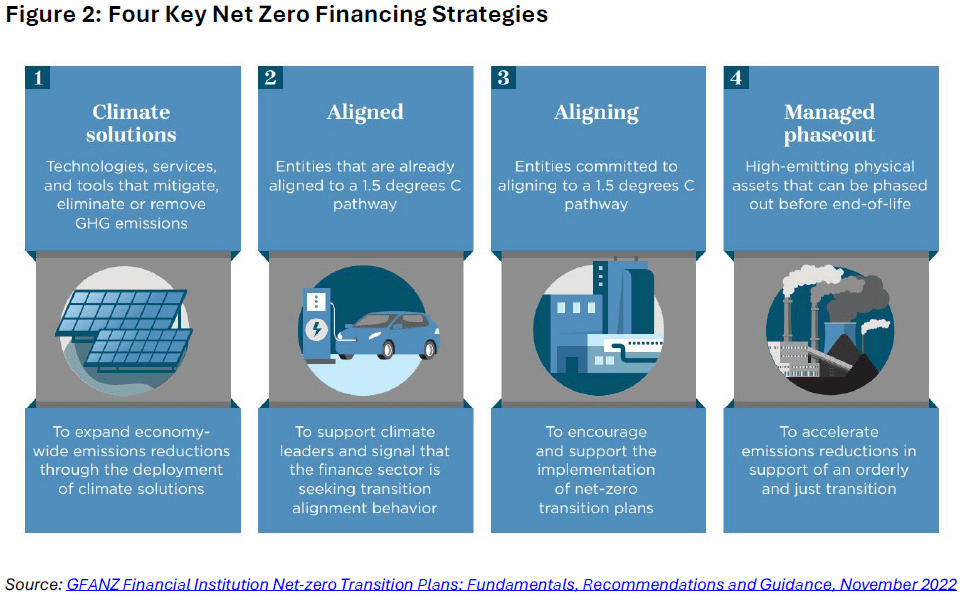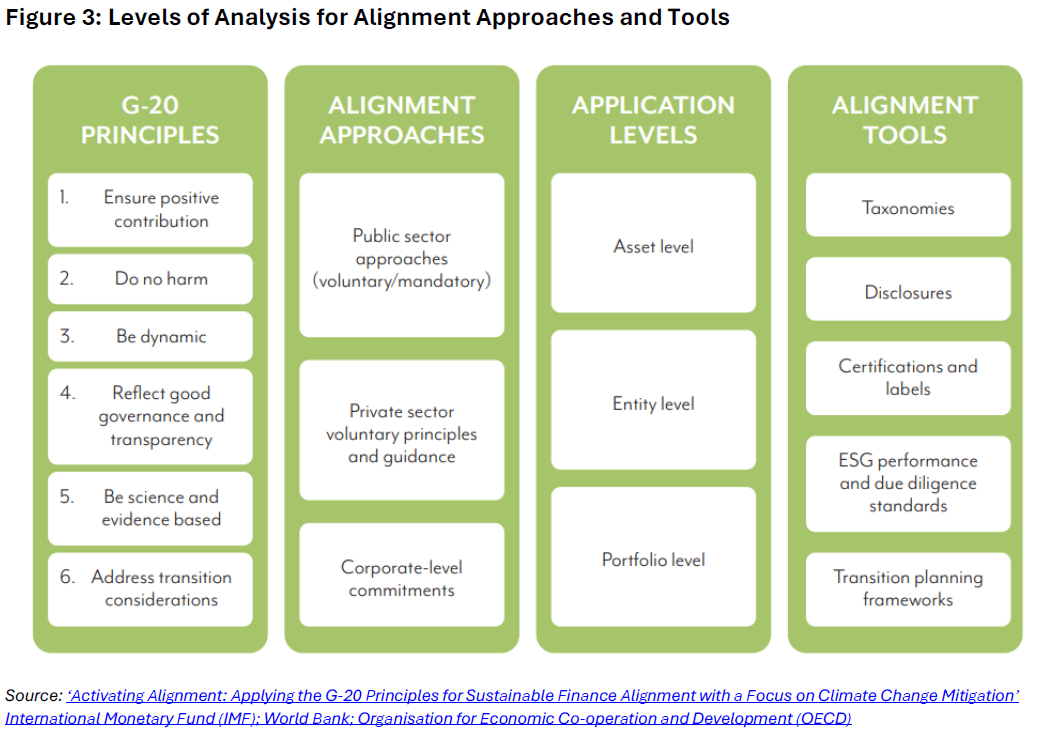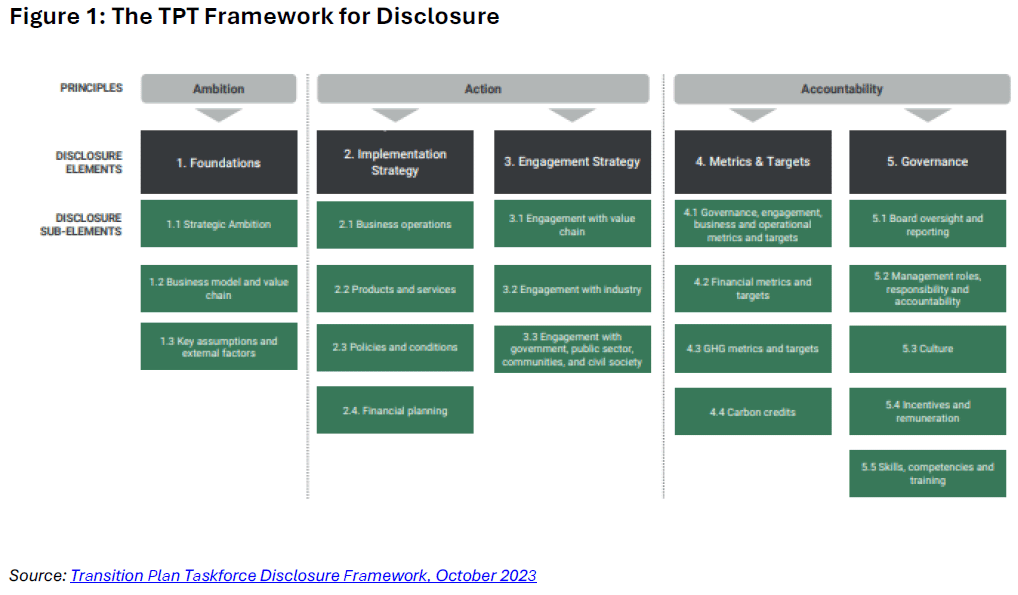
Given the scientific consensus on the need for rapid cuts in greenhouse gas emissions to meet Paris Agreement targets, companies are increasingly focused on reaching net zero. In 2021, the Taskforce on Climate-related Financial Disclosures (TCFD) recommended the introduction of climate transition plans, which should be disclosed. These, it argued, would be needed to allow investors to determine the credibility of firms’ climate-related commitments.
Since then, there has been a growing focus on transition planning, including from regulators, standard setters and investors. To help navigate this increasingly complex landscape, we’ve created an introductory guide to some of the key players and concepts.
Jo Paisley
What a Transition Plan Can Look Like
One of the first things to note is that the nature of the transition will differ across firms. Most decarbonization will take place in the real economy — that is across non-financial firms which are responsible for the bulk of greenhouse gas emissions. Financial firms, in contrast, contribute little directly to greenhouse gas emissions, but have an important role in supporting the transition through their financing, underwriting and investing.
Credible transition plans are needed from both types of firms, not only to guide firms’ own strategies, but also to communicate those plans to the wider investor and stakeholder community. But the financial firms will be both users of the plans of their real economy counterparties as well as preparers of their own plans.
In April 2023, the Network for Greening the Financial System (NGFS) published a useful stock take of transition planning, recognizing the potential importance of these plans in supporting the efficient allocation of capital across sectors in the transition to a net zero world. They found that there were multiple definitions of transition plans, with some more risk-focused and others more strategically focused (e.g., on communications with stakeholders).
Initial Steps for Creating a Transition Plan
A new disclosure framework, recently published by the Transition Plan Taskforce (TPT) in the U.K., provides helpful guidance for firms trying to work out how to create a transition plan.
There are three principles which underpin the guidance: ambition, action and accountability.
- On ambition, the framework makes clear the urgency of action, but also the scope of action required. To avoid unintended consequences, firms need to think more broadly than the decarbonization of their own entities. Consider a bank that sells a high emitting counterparty, such as a coal-fired power station, to a private equity firm. Although it may make the bank’s balance sheet look greener, has this done anything to lower real world emissions? What if that private equity firm has plans to increase the output of the power station? The TPT has, therefore, suggested firms take a ‘strategic and rounded’ approach to decarbonization, which means that they should think beyond their own operations to consider how they can contribute to the economy-wide transition.
- On action, the TPT urges concrete steps over the short, medium and longer term. Good practice transition plans should consider Scope 1, 2 and 3 emissions and should prioritise decarbonization through direct abatement over purchasing carbon credits.
- And on accountability, the transition plan should be integral to the entity’s wider corporate strategy and culture.
These three principles then underpin five elements for disclosure (Figure 1).
The recommendations also make it clear that transition plans can serve many purposes, including:
- Setting a blueprint for actions within firms
- Improving the information provided to investors and lenders
- Helping policy makers and regulators better understand the trajectory of the transition
- Holding stakeholders to account for their public commitments
- Acting as a reference point for financial instruments and products
- Providing valuable information to the wider capital markets ecosystem
Transition Planning Resources for Financial Firms
While TPT is a disclosure framework, there are other transition planning resources designed specifically for financial firms.
An example of a useful set of resources is the one provided by the Glasgow Financial Alliance for Net Zero (GFANZ). GFANZ was launched in April 2021 to drive more financial institutions to make net-zero commitments, as well as to establish a forum for addressing sector-wide challenges associated with the transition. It is an umbrella to eight sector-specific alliances, including the Net-Zero Asset Owner Alliance (NZAOA), the Net-Zero Asset Managers initiative (NZAM), the Paris Aligned Asset Owners (PAAO), the Net-Zero Banking Alliance (NZBA) and the Net-Zero Insurance Alliance (NZIA).
GFANZ issued guidance on transition planning for financial firms, which the TPT has also drawn on, ensuring that the two are aligned. Like the TPT, GFANZ emphasizes the need to drive real world emissions reductions (that is, not just removing emissions from a portfolio).
Underpinning the approach are four key net-zero financing strategies, as shown in Figure 2.
 A financial institution can review its entire portfolio through the lens of these four strategies, which can be a helpful basis on which to position its own transition plan.
A financial institution can review its entire portfolio through the lens of these four strategies, which can be a helpful basis on which to position its own transition plan.
GFANZ has also produced guidance on the expectations financial firms should have for the transition plans of real economy companies. This is helpful for assessing the credibility of transition plans, which is likely to become a growing area of focus for those working in risk management. (A recent GARP webcast also provides useful information about the GFANZ approach.)
Ensuring the Credibility of Transition Plans
In parallel with the increase in the number of criteria and benchmarks to set net-zero commitments is the potential rise of greenwashing.
The good news is that the international policy community is aware of these risks. The United Nations High-Level Expert Group on Net Zero Emissions Commitments of Non-State Entities published a report at the 2022 UN Climate Conference (COP27), which made 10 recommendations that can serve as a how-to guide for credible, accountable net-zero pledges. It includes such points as:
- Non‑state actors cannot claim to be net zero while continuing to build or invest in new fossil fuel supply.
- Deep reductions in emissions across value chains need to be prioritized. High integrity carbon credits in voluntary markets cannot be counted toward interim emissions reductions. Any such carbon credit must meet the criteria of additionality and permanence.
- Non-state actors should focus on reducing their absolute emissions rather than the intensity of their emissions.
- Non-state actors cannot lobby to undermine ambitious government climate policies either directly or through trade associations or other bodies.
We can expect more of a focus on the credibility of transition plans at COP28 at the end of 2023, as well as by regulators.
The Growing Complexity of Net-Zero Approaches
Another potential roadblock to the smooth roll out of credible and coherent transition plans is the growing complexity of different approaches for reaching net-zero. Recent work by the IMF, World Bank and OECD has also investigated the variety of approaches that are being used to measure alignment.
Alongside transition planning at an entity level, Paris Agreement alignment can also be considered at the level of an asset or a portfolio (Figure 3).
 Their work indicates a degree of concern over how all these frameworks fit together and sets out some underlying principles that alignment approaches ought to adopt, namely:
Their work indicates a degree of concern over how all these frameworks fit together and sets out some underlying principles that alignment approaches ought to adopt, namely:
1. Ensure material positive contributions to sustainability goals and focus on outcomes.
2. Avoid negative contributions to other sustainability goals (such as by doing no significant harm to any sustainability goal requirements).
3. Be dynamic in adjustments reflecting changes in policies, technologies, and the state of the transition.
4. Reflect good governance and transparency.
5. Be science-based for environmental goals and science or evidence-based for other sustainability issues.
6. Address transition considerations (e.g., supporting a just transition).
It also makes it clear that the technical complexity of these approaches may warrant regulation over time.
Parting Thoughts
The focus on transition plans is increasing across the global For example, the U.S. Department of the Treasury recently published their Principles for Net-Zero Financing & Investment.
In the EU, the Corporate Sustainability Reporting Directive and the European Sustainability Reporting Standards contain transition plan disclosure requirements, while the U.K. is moving toward making publication of transition plans mandatory. Lastly, in Asia, the Monetary Authority of Singapore recently released a consultation on transition planning by financial firms. This focus is likely to intensify even further, with more regulators and authorities making them mandatory, and with a focus on driving greater comparability across alignment approaches, possibly through regulation.
Bottom line: If transition plans aren’t on your company’s board agenda already, then need to be — and quickly.
Jo Paisley, President of the GARP Risk Institute, has worked on a variety of risk areas at GARP Risk Institute, including stress testing, operational resilience, model risk management and climate risk. Her career prior to joining GARP spanned public and private sectors, including working as the Director of the Supervisory Risk Specialist Division within the Prudential Regulation Authority and as Global Head of Stress Testing at HSBC
GARP’s Sustainability and Climate Risk (SCR®) Certificate provides the foundation needed to tackle climate related risks and help prepare for future regulatory climate mandates.
Topics: Transition Risk
